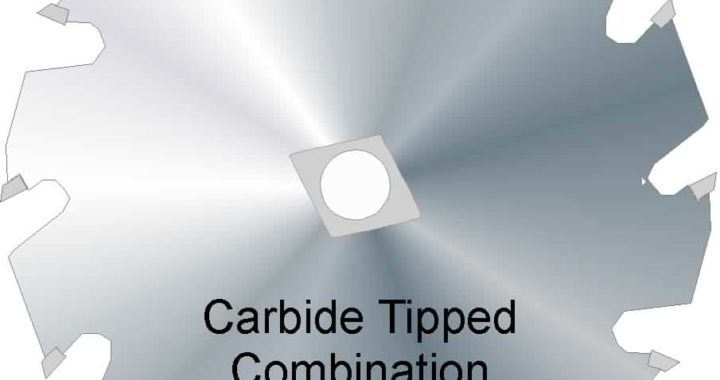Table Saw (Download)
Table Saw Safety Table Saw The table saw is a versatile woodworking tool consisting of a circular saw blade, mounted on a table, that is driven by an electric motor. The blade extends through the surface of a table, which provides support for the material, usually wood being cut. Table saws are used for straight sawing. Depending on the blade, they cut either across (crosscut) or with (ripsaw) the grain of the wood. Parts of Table Saw http:// www.raygirling.com/ryobi/ryobi.htm#features Blades A wide variety of blade sizes and teeth configurations are available for different cuts and finishes. Blades are classified by the following type of teeth: a. Cross cut b . Ripping c . Combination d . Plywood Cut Types Bench Top Table Saw Lightweight Portable Least expensive Reduced cutting capacity of stock due to relative small size of table surface. Source: http://en.wikipedia.org/wiki/Table_saw Contractor Table Saw Larger than bench top saws. Attached base. May be on wheels. Source: http://en.wikipedia.org/wiki/Table_saw 1 to 2 HP motor mounted on the rear of the saw. Most popular among homeowners. Cabinet Table Saw Largest of all table saws. 3 to 5 HP motor. Motor encased in cabinet below the saw . Requires a 220V connection. Source: http://en.wikipedia.org/wiki/Table_saw Table saws are a common tool to have in the construction industry. Among motorized saws, the table saw is an essential tool among woodworkers . Used most commonly for ripping plywood or cutting dimensional lumber to length. In the Field History Table saws have been around for about 200 years and most point to Samuel Miller of England as the original inventor though not everyone can agree on exactly who invented the table saw. Before the invention of electricity, early circular table saws were operated in a number of means including using a foot pedal (as on a spinning wheel) or even water-powered when positioned near rivers. Before the Cut Inspect Blades For: -Chips, Cracks and Warps, Always use Sharp Blades, Correct Type Be sure saw is oiled and clean. Be sure all surfaces are stable and level. Check for location of cord. Keep area beneath saw clean. During the Cut Engage trigger prior to cut. Be aware of the surroundings but keep the eyes on the saw while operating it. Cut at a constant speed with deliberate motion. Use Both Hands – Keep them at a reasonable distance from blade. Use a push stick for small pieces of wood and for pushing stock past the blade. After the Cut At the Completion of the task: -Unplug the electrical cord Identify and remove any trip hazards. Dispose of all debris. Safety Concerns Machine hazards – Point of operation – Fast moving rotary blade – In-running nip points (pinch points) Kickbacks Flying chips, material Hearing or Eye Damage Tool projection Electrical hazards Lung Damage Injury Causes Inexperienced operator Improper training Inadequate or missing guards Employee taking shortcuts / rushing Distracted operator Substance abuse Typical Safety Guards and Signs Safety Do’s Read the operators manual! Adjust the blade as appropriate for material. Plan the cut. Keep a clean work area. Stabilize all material to be cut. Safety Do Not’s Apply too much downward pressure while cutting. Saw on uneven ground or uneven surfaces. Remove manufacturer installed guards. Operate without proper safety training. Injury Data A 2001 report documented many injuries were related to stationary power saws: Approximately 93,880 injuries treated in hospitals related to saws. Of those 93,880, approximately 36,400 were related to stationary saws. Table saws were responsible for the majority of those stationary saw injuries. Source: http://www.cpsc.gov/library/foia/foia03/os/powersaw.pdf OSHA-Investigated Fatalities In the 20 year span, from 1990 thru 2009, there were 2 fatalities related to table saws. Source: Extracted from OSHA Accident Investigation Data 1990- 2009 Accident Descriptions In one of the fatalities investigated by OSHA, a worker was using a table saw. The following took place: The blade began to bind. The material kicked-back and struck the worker. Due to the worker’s previous history of poor health (severe cirrhosis), he began bleeding internally. Doctors were unable to stop the bleeding and the worker passed away. Source: Extracted from OSHA Accident Investigation Data 1990-2007 Injury Data Source: http://www.cpsc.gov/library/foia/foia03/os/powersaw.pdf 1 = Injuries by stationary saws 2 = Injuries by personal or handheld saws 3 = Injuries by unspecified saws OSHA Regulations 1926.304(a) Disconnect switches. All fixed power driven woodworking tools shall be provided with a disconnect switch that can either be locked or tagged in the off position . 1926.304(h)(1) Each circular crosscut table saw shall be guarded by a hood which shall meet all the requirements of paragraph (i)(1) of this section for hoods for circular ripsaws. Source: http://www.osha.gov/pls/oshaweb/owadisp.show_document?p_id=10692&p_table=STANDARDS OSHA Regulations 1926.304(i)(1) Each circular hand-fed ripsaw shall be guarded by a hood which shall completely enclose the portion of the saw above the table and that portion of the saw above the material being cut. The hood and mounting shall be arranged so that the hood will automatically adjust itself to the thickness of and remain in contact with the material being cut but it shall not offer any considerable resistance to insertion of material to saw or to passage of the material being sawed. The hood shall be made of adequate strength to resist blows and strains incidental to reasonable operation, adjusting, and handling, and shall be so designed as to protect the operator from flying splinters and broken saw teeth. It shall be made of material that is soft enough so that it will be unlikely cause tooth breakage. the hood shall be so mounted as to insure that its operation will be positive, reliable, and in true alignment with the saw; and the mounting shall be adequate in strength to resist any reasonable side thrust or other force tending to throw it out of line. Source: http://www.osha.gov/pls/oshaweb/owadisp.show_document?p_id=10692&p_table=STANDARDS Table Saw Safety Rules: Always use the blade guard. The saw blade should be adjusted to cut above the wood no more than 1/8”. All adjustments are to be made when the saw is at a complete stop. Freehand cuts should not be attempted on the table saw. To prevent injury in case of kickback, always stand to the side of the blade. Table Saw Safety Rules : (cont.) Never reach across the blade to retrieve a piece of wood that has been cut. When tilting the blade, check to be sure it does not hit the guard, rip fence or miter gauge before turning the saw on. Never start cutting until the saw has attained full speed. When starting the saw , if it does not sound right, turn it off immediately. Never remove scrap wood from the saw while it is turning. Table Saw Safety Rules (cont.) Crosscutting: Fingers should never be closer to the blade than 4”. Check miter gauge to be sure it slides freely and clears the blade. Set proper angle to be cut and lock in place before turning the saw on. Rip fence must be clear of work area. Never use rip fence and miter gauge at the same time. All work must be held firmly against the miter gauge. Table Saw Safety Rules (cont.) Ripping: Edge of wood touching rip fence must be straight and smooth. Check fence to be sure it is locked in place before turning the saw on. Use a push block for wood narrower than 4”. Assistance must be available when ripping long pieces of wood. Wood should never be left between the fence and the blade. www.tech. purdue.edu/It/Courses/IT278/Files/Safety.ppt How to Avoid Accidents Wear Personal Protection Equipment: Gloves Hearing Protection Safety Glasses Mask Long sleeves Pants Kickback Apron Have the mindset that every tool can pose a threat. Read instructions before operating. Innovations in Technology In the past, in order to adjust the height of the blade the table height was actually adjusted to make the blade shallower or deeper. Now, most saws have levers that can be used to adjust the blade height in a matter of seconds. Saw guards, which are required by OSHA, have been introduced to act as another means of protection between operator and machine. Source: http://www.osha.gov/pls/oshaweb/owadisp.show_document?p_id=10692&p_table=STANDARDS Innovations in Technology SawStop is the most recent innovation in technology. Current is run through the machine and when contacted by humans (which also carry current), it sends a signal to the safety system and the brake is applied in 5 milliseconds. A spring is thrust into the blade to stop it. The blade is lowered into the table to reduce further risk of injury. Power to the machine is shut off. All this is done faster than the airbag in a car is deployed in an accident. Source: http://www.sawstop.com/howitworks/how_monitor. php http:// www.sawstop.com / SawStop Video: http://www.youtube.com/watch?v=OMD3agP5hv0 Think Safety Work Safely

